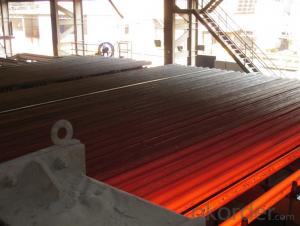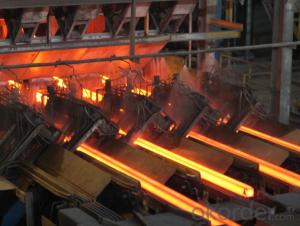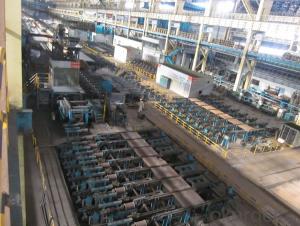Square Steel Billet Q235 3SP Grade Prime Quality 5#
- Loading Port:
- Tianjin
- Payment Terms:
- TT OR LC
- Min Order Qty:
- 2000 m.t
- Supply Capability:
- 50000 m.t/month
OKorder Service Pledge
OKorder Financial Service
You Might Also Like
Description of Square Steel Billet Q235 Grade Prime Quality 5#
M. S. Billets are used for rolling of TMT Re-Bars of Fe415 and Fe500 Grade and various other structural steel products.
CRS Billets are used for rolling of CRS TMT Re-Bars.
Special Alloy Billets are used for rolling of any special grade TMT Re-Bars like Earthquake resistant TMT Re-Bars and for special grade structural steel products.
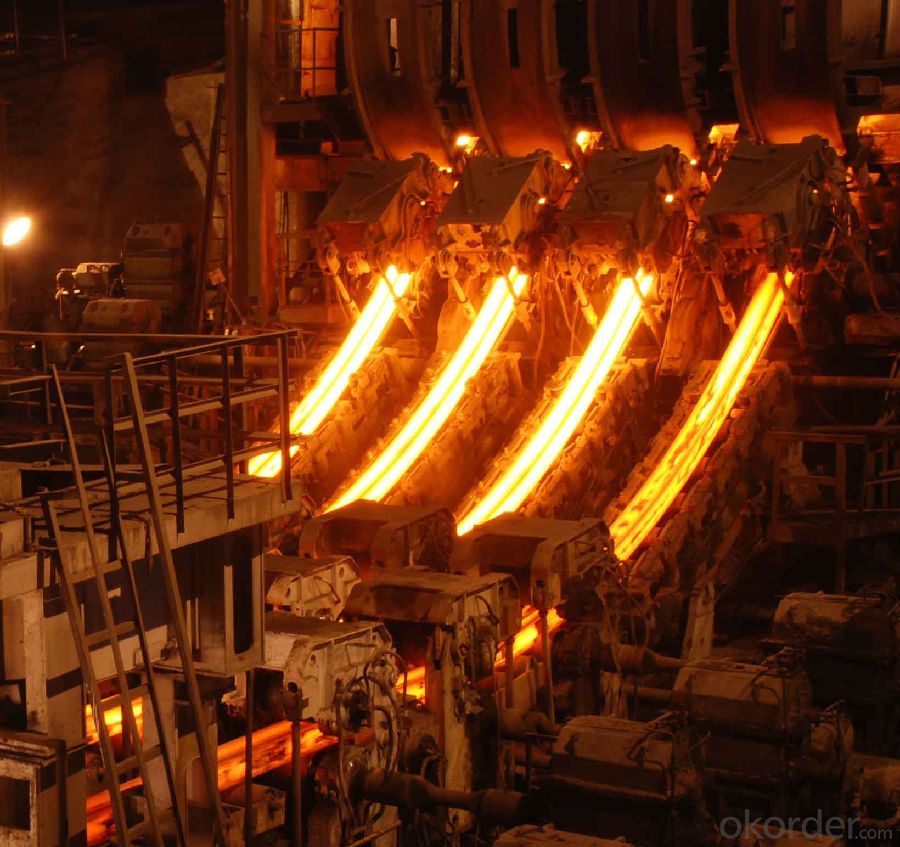
Main Feature Square Steel Billet Q235 Grade Prime Quality 5#
Raw elements(C,Fe,Ni,Mn,Cr,Cu.)---Smelted ingots by AOD finery---hot rolled into black suface---pickling in acid liquid---cold drawn----polished by automatically machine--- cutting into pieces---checking quanlity
Applications of Square Steel Billet Q235 Grade Prime Quality 5#
Widely Used in the areas such as Stainless Steel Fasteners, Chains, Kitchen and Sanitary wares, Furniture handles, Handrails, Electroplating and Electrolyzing pendants, Foods, Electron, Petroleum, Construction and Decoration, etc. Products have a high strength after cold-working. Electronic products parts, Medical appliance, Springs, Bus Inside and Outside packaging and building, Street Lamp Posts, etc. Decoration materials and Outdoor Publicity Billboard. Used for the products which have the Anti-Stress Corrosion requirement. Electron Products, Table-wares, Bolts, Nuts, Screen Meshes, Cumbustors and so on.
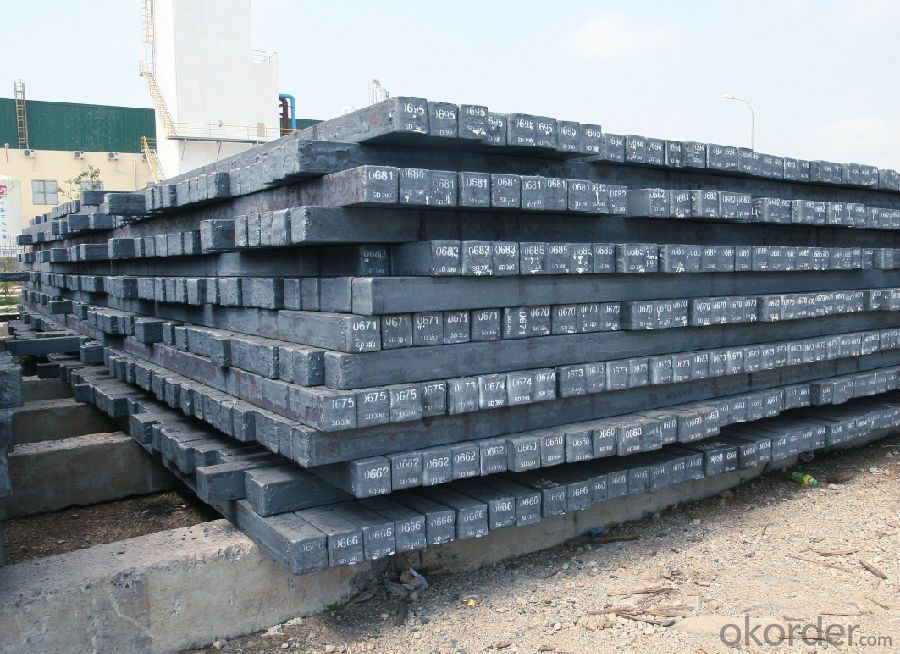
Specifications of Square Steel Billet Q235 Grade Prime Quality 5#
| Standard | C(%) | Mn(%) | S(%) | P(%) | Si(%) |
| Q195 | ≤0.12 | ≤0.50 | ≤0.040 | ≤0.035 | ≤0.30 |
| Q235 | ≤0.20 | ≤1.40 | ≤0.045 | ≤0.045 | ≤0.35 |
| Q275 | ≤0.22 | ≤1.50 | ≤0.045 | ≤0.045 | ≤0.35 |
| 20MnSi | 0.17-0.25 | 1.2-1.6 | ≤ 0.050 | ≤ 0.050 | 0.40-0.80 |
| 3SP | 0.14-0.22 | 0.40-0.85 | ≤ 0.050 | ≤ 0.040 | 0.05-0.15 |
| 5SP | 0.28-0.37 | 0.50-1.00 | ≤ 0.050 | ≤ 0.040 | 0.15-0.30 |
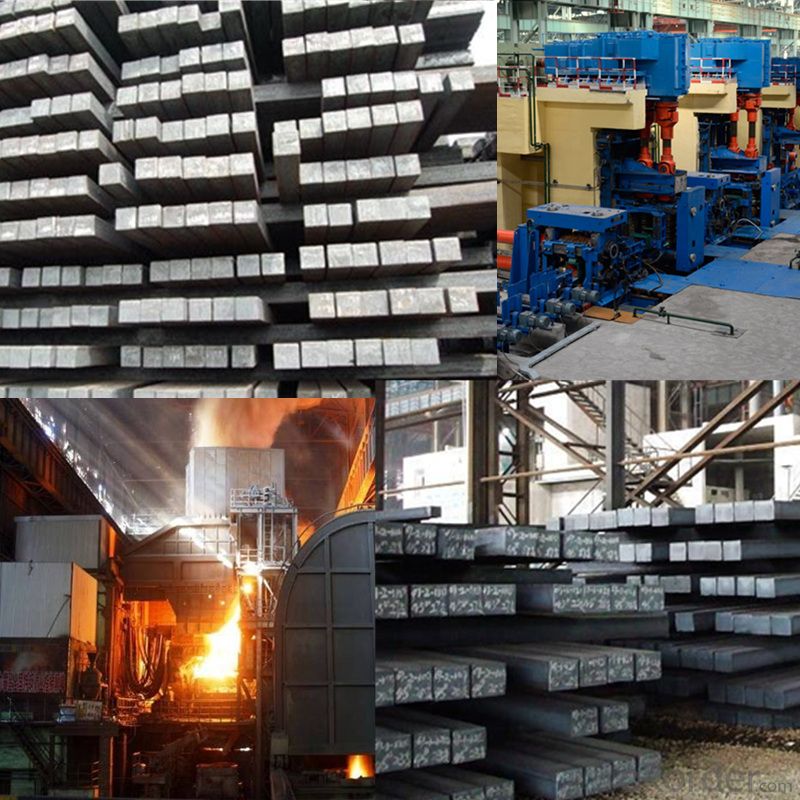
FAQ of Square Steel Billet Q235 Grade Prime Quality 5#
We have organized several common questions for our clients,may help you sincerely:
1. How Can I Visit There?
Our company is located in Tianjin City, China, near Beijing. You can fly to Tianjin Airport Directly. All our clients, from home or aboard, are warmly welcome to visit us!
2. How Can I Get Some Sample?
We are honored to offer you sample.
3. Why choose CNBM?
Our delivery time about 15-20days for standard sizes, if you have other requirements like hardness, quanity and width ,it is about 20-40days. But don't worry we also try our best for the delivery time ,because time longer and our cost is higher.
- Q:What is the role of steel billets in the manufacturing of construction machinery?
- The exceptional strength and durability of steel billets make them crucial in the production of construction machinery. These semi-finished products, created from molten steel, can be shaped into various forms like bars, rods, or sheets, depending on the specific machinery being manufactured. The ability of steel billets to withstand heavy loads and extreme conditions is one of the primary reasons for their use in the construction machinery industry. Machinery like excavators, bulldozers, cranes, and loaders experience intense stress and pressure during operation. With their high-quality steel composition, steel billets provide the necessary structural integrity and resistance to deformation, ensuring the machinery can handle demanding tasks without compromising safety or performance. Additionally, steel billets offer excellent weldability, an essential characteristic in the manufacturing process of construction machinery. Welding is often required to join different components together, and the use of steel billets guarantees strong and reliable welds, contributing to the overall stability and longevity of the machinery. Furthermore, steel billets can be easily machined and formed into complex shapes, allowing for the production of intricate parts and components needed for construction machinery. This versatility empowers manufacturers to design and fabricate machinery with precise specifications, enhancing their functionality and efficiency on the job site. Moreover, steel billets are known for their resistance to corrosion and rust, making them ideal for construction machinery exposed to harsh environmental conditions like moisture, chemicals, and abrasive materials. This resistance ensures the longevity of the machinery, reducing maintenance costs and downtime. In conclusion, the strength, weldability, machinability, and resistance to corrosion of steel billets make them indispensable in the manufacturing of construction machinery. By incorporating steel billets into the production process, manufacturers can create robust and reliable machinery that can withstand heavy loads, extreme conditions, and perform efficiently in the construction industry.
- Q:How are steel billets used in the production of agricultural machinery?
- Steel billets are an essential component in the production of agricultural machinery. These billets, which are semi-finished metal products, are used as raw material for manufacturing various parts and components of agricultural machinery. Agricultural machinery, such as tractors, harvesters, and plows, require strong and durable structures to withstand the demanding conditions of agricultural operations. Steel billets provide the ideal material for constructing these robust structures due to their high strength, excellent mechanical properties, and resistance to corrosion. Steel billets are first melted and cast into their basic shape, which is typically a rectangular or square cross-section. They are then further processed through various techniques like forging, rolling, or extrusion to shape them into specific parts required for agricultural machinery. These parts may include axles, gears, shafts, blades, and brackets, among others. The use of steel billets in agricultural machinery production ensures the final products have the necessary strength, durability, and reliability to perform efficiently in farm operations. These machines often operate in harsh environments, such as uneven terrains, heavy loads, and exposure to moisture and chemicals. Steel's inherent properties make it the ideal choice for ensuring the longevity and performance of agricultural machinery. Moreover, steel billets offer versatility in design and customization. Agricultural machinery manufacturers can easily modify the shape, size, and dimensions of steel billets during the production process to meet the specific requirements of each machine. This flexibility allows for the creation of more efficient and specialized equipment to cater to various agricultural tasks. In conclusion, steel billets play a crucial role in the production of agricultural machinery, providing the necessary strength and durability required for farm operations. Their versatility, strength, and resistance to corrosion make them an ideal choice for manufacturing various components of agricultural machinery, ensuring the reliability and longevity of these machines in demanding agricultural environments.
- Q:What are the main challenges in the handling of steel billets during production?
- The production of steel billets poses various challenges that must be addressed in order to achieve a streamlined and effective manufacturing process. Weight and size are major obstacles to consider when working with steel billets. These billets can be quite hefty, ranging from a few hundred kilograms to several tons, depending on their dimensions. As a result, lifting and moving them within the production facility can be difficult. The safe handling of these heavy loads necessitates the use of specialized equipment, such as cranes and forklifts. Another challenge lies in the potential for damage during the handling of steel billets. They are typically transported and stored in stacks or bundles, and improper handling techniques or inadequate protection can result in deformation, scratches, or even breakage of the billets. These damages can negatively impact the quality of the final product, leading to increased scrap rates and production costs. Furthermore, maintaining precise temperature control is crucial when working with steel billets. Steel is highly sensitive to temperature changes, and the billets must be kept within specific temperature ranges to prevent distortion or metallurgical issues. Careful attention must be paid when transferring billets between different areas of the production facility to ensure consistent temperatures. Proper inventory management and tracking also present challenges in the handling of billets. Steel billets are often stored in large warehouses or outdoor yards, and keeping track of their location, quantity, and quality can be complex. Efficient inventory management systems, such as barcoding or RFID tagging, are essential to minimize errors and facilitate the retrieval of the necessary billets for production. Lastly, safety is a significant concern when handling steel billets. The weight of the billets and the potential for injury make it imperative to adhere to strict safety protocols. Operators must receive proper training on the use of equipment, such as cranes and forklifts, and wear appropriate personal protective equipment (PPE) to prevent accidents or injuries. In conclusion, the handling of steel billets during production presents challenges related to weight, potential damage, temperature control, inventory management, and safety. Overcoming these challenges necessitates investments in specialized equipment, training, and efficient processes to ensure a smooth and successful production operation.
- Q:Can steel billets be welded together?
- Yes, steel billets can be welded together. Welding is a commonly used method to join steel billets, which are semi-finished products in the form of a rectangular or square solid metal. By applying heat and pressure, the steel billets can be fused together, creating a strong and durable bond. Welding processes such as arc welding, gas welding, and laser welding can be used to join steel billets, depending on the specific requirements and properties of the steel. However, it is important to note that the proper welding technique and expertise are crucial to ensure a successful and high-quality weld joint.
- Q:What is the role of steel billets in the construction of railway stations?
- Steel billets play a crucial role in the construction of railway stations as they are used to fabricate various structural components, such as beams, columns, and trusses. These components provide the necessary support and stability to the station infrastructure, ensuring the safety and durability of the building. Steel billets are also utilized in the construction of railway tracks, where they are transformed into rails, sleepers, and other track elements, enabling the smooth and efficient operation of trains.
- Q:Can steel billets be used in the production of oil and gas equipment?
- Yes, steel billets can be used in the production of oil and gas equipment. Steel billets are commonly used as the raw material in the manufacturing process of various oil and gas equipment such as pipelines, valves, and drilling equipment. The high strength and durability of steel make it suitable for the challenging conditions and demands of the oil and gas industry.
- Q:What are the different types of coating processes used for protecting steel billets?
- There are several different types of coating processes used for protecting steel billets. These processes aim to prevent corrosion and improve the durability of the steel billets. Some of the commonly used coating processes include: 1. Hot-dip galvanizing: This process involves dipping the steel billets into a bath of molten zinc. The zinc forms a protective layer on the surface of the steel, preventing corrosion and providing long-lasting protection. 2. Electroplating: In this process, a thin layer of metal such as zinc, nickel, or chrome is deposited onto the surface of the steel billets using an electric current. The metal layer acts as a barrier against corrosion and enhances the appearance of the steel. 3. Powder coating: Powder coating involves applying a dry powder onto the surface of the steel billets, which is then heated to form a protective layer. This process provides excellent resistance to corrosion, chemicals, and UV rays. 4. Thermal spray coating: This process involves spraying a melted or heated material onto the surface of the steel billets. The coating material can be metal alloys, ceramics, or polymers. Thermal spray coatings offer high wear resistance, corrosion protection, and thermal insulation. 5. Paint coating: Applying paint onto the surface of steel billets is a common method of protection. The paint acts as a barrier against moisture and atmospheric elements, preventing corrosion and maintaining the appearance of the steel. Each of these coating processes has its own advantages and is suitable for different applications. The choice of coating process depends on factors such as the desired level of protection, environmental conditions, and cost considerations.
- Q:What is the typical production process for steel billets?
- The process of producing steel billets typically involves a series of steps. Initially, raw materials like iron ore, coal, and limestone are acquired. These materials are then processed and converted into iron through a blast furnace or direct reduction method. To eliminate impurities and adjust the composition, the iron is further refined in either a basic oxygen furnace or an electric arc furnace. Once the iron has been refined, it is poured into large rectangular molds known as ingots. These ingots are subsequently heated and rolled into semi-finished products called blooms or slabs. Blooms usually have a square or rectangular shape, whereas slabs are flat and rectangular in form. The next stage is to further process the blooms or slabs into billets. This is achieved by reheating the semi-finished products and passing them through a sequence of rolling mills. The rolling mills exert pressure to shape the metal and decrease its thickness. This process, known as hot rolling, takes place. After hot rolling, the billets are cooled and carefully examined for any defects. They may also undergo additional processes, such as surface treatment or heat treatment, to enhance their properties. Finally, the billets are typically cut into desired lengths and stored before undergoing further processing or being shipped to customers. In conclusion, the production of steel billets involves obtaining raw materials, refining the iron, casting it into semi-finished products, hot rolling, and conducting final inspection and processing. This comprehensive process ensures that the steel billets meet the necessary specifications and quality standards before being utilized in various industries, including construction, automotive, and manufacturing.
- Q:What is alpha carbon? What is beta carbon?
- The method of marking C is generally used in organic matter, and the C atom directly connected with the functional group is called alpha carbon. The C atom separated from the functional group is called C beta atom, and alpha carbon and beta carbon are not unique
- Q:What are the different sizes and shapes of steel billets?
- Steel billets are available in a range of sizes and shapes, which are determined by their intended use and production method. Typically, steel billets have a rectangular shape with different dimensions. The commonly used sizes vary from 100mm x 100mm to 300mm x 300mm, and their lengths typically range from 3 to 12 meters. Apart from the standard rectangular shape, steel billets can be manufactured in various other shapes to meet specific requirements. Examples of these shapes include round billets, square billets, and octagonal billets. Round billets have a circular cross-section, while square billets have four equal sides. Octagonal billets, on the other hand, have eight sides, which contributes to increased surface area and improved thermal conductivity. The choice of size and shape for steel billets is influenced by multiple factors, including the type of steel being produced, the desired strength and durability, and the manufacturing process. These factors have an impact on the properties of the final product and its ability to withstand specific applications, such as construction, automotive manufacturing, or machinery production.
1. Manufacturer Overview |
|
|---|---|
| Location | |
| Year Established | |
| Annual Output Value | |
| Main Markets | |
| Company Certifications | |
2. Manufacturer Certificates |
|
|---|---|
| a) Certification Name | |
| Range | |
| Reference | |
| Validity Period | |
3. Manufacturer Capability |
|
|---|---|
| a)Trade Capacity | |
| Nearest Port | |
| Export Percentage | |
| No.of Employees in Trade Department | |
| Language Spoken: | |
| b)Factory Information | |
| Factory Size: | |
| No. of Production Lines | |
| Contract Manufacturing | |
| Product Price Range | |
Send your message to us
Square Steel Billet Q235 3SP Grade Prime Quality 5#
- Loading Port:
- Tianjin
- Payment Terms:
- TT OR LC
- Min Order Qty:
- 2000 m.t
- Supply Capability:
- 50000 m.t/month
OKorder Service Pledge
OKorder Financial Service
Similar products
New products
Hot products
Related keywords



